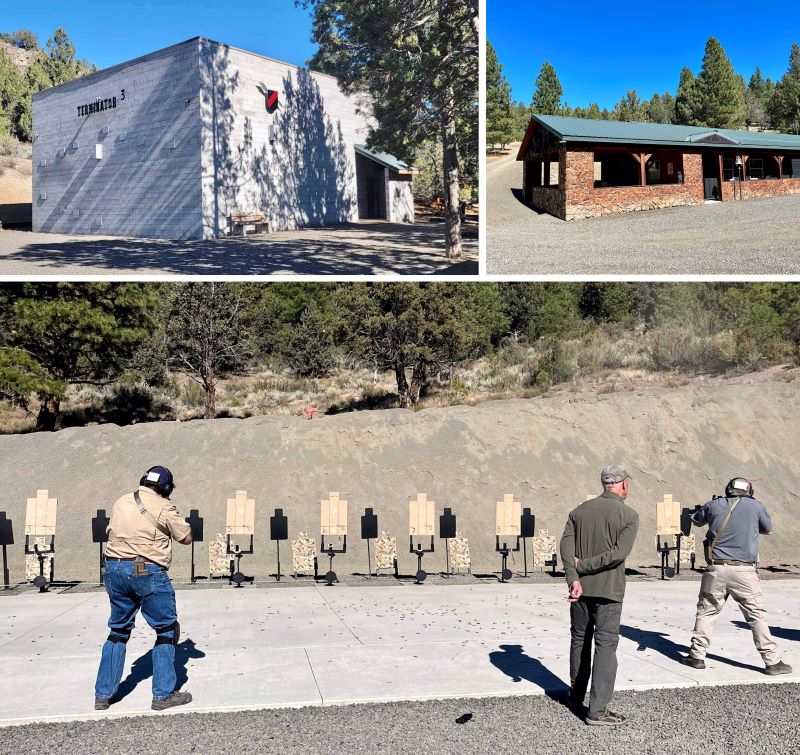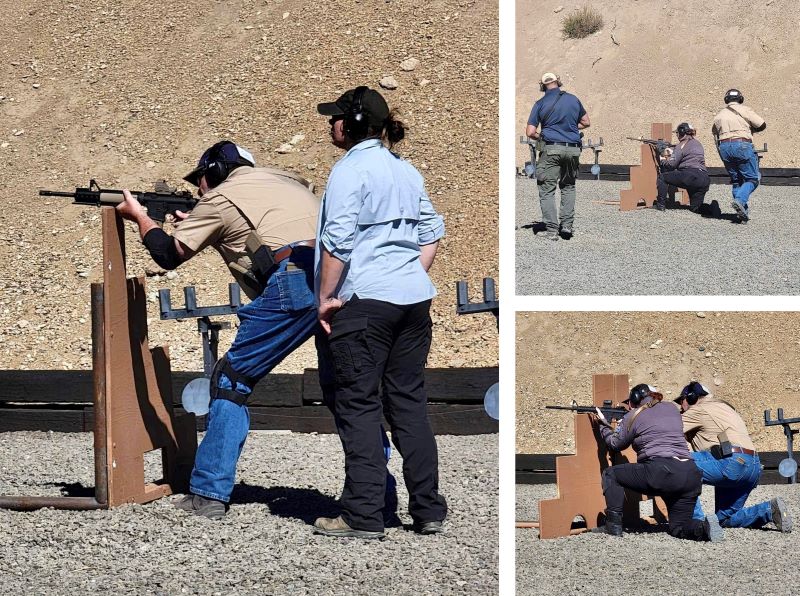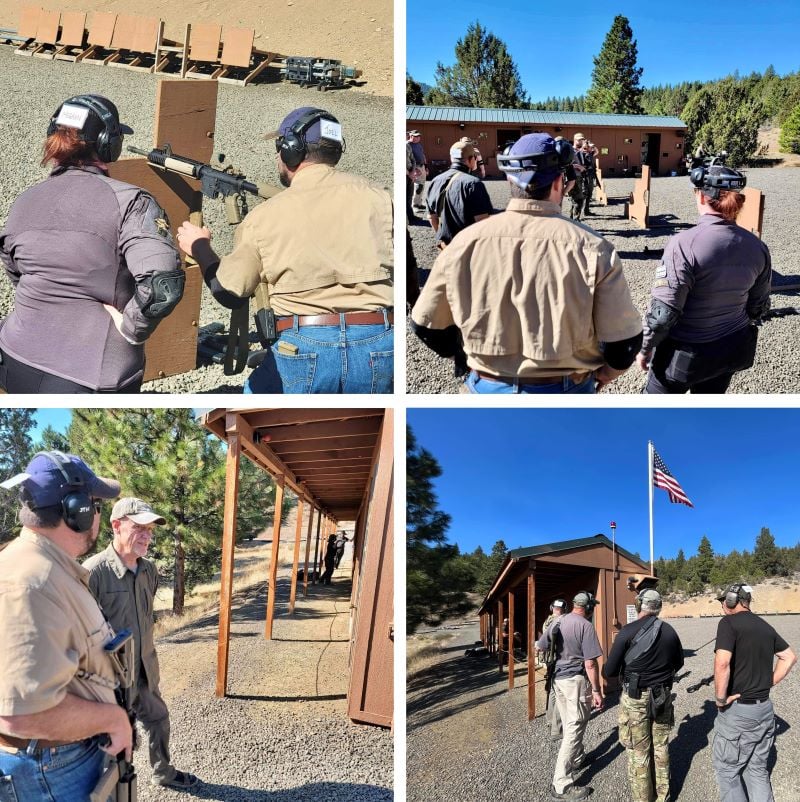I will admit to having a bucket list of classes and training academies. In the past five years, my wife Meghan and I have managed to scratch off quite a few from the list and recently we were able to attend Urban Rifle with Clint Smith at Thunder Ranch in Lakeview, Oregon. One of the delays in taking a class with Clint Smith was the location. Thunder Ranch isn’t easy to get to, as it’s at least a three-hour drive from the closest airport. We ultimately decided to make a visit to Reno at the start of a full week, vacationing in the Reno area for three days, then driving a rental up to Lakeview for the class.
Things to Know Before You Go
First and foremost, Thunder Ranch’s training programs are primarily held in Oregon, but there are some classes offered in the Las Vegas area as well. The class does require frangible ammunition, which can be pre-bought and is waiting for you at the class. Additionally, the range was full of loose rock with a lot of kneeling and prone work, thus the suggestion of knee and elbow pads should be taken seriously. For the rifle class, the instructors are strong proponents for a 100-yard zero on the rifle’s sights. I would say that if you disagree and know how to zero your sights, go ahead and zero to 100 yards during this class, as you can always re-zero afterward. If you are new to zeroing, take the opportunity to complete a 100-yard zero, as it is not a bad option. Similarly, make sure you have backup iron sights on your weapon.
The class is very active, and I would estimate at least 50% or more of the students at some point had to switch, even if for just one drill, to iron sights due to optic issues. Your rifles will be hanging on slings between drills and having a good sling that you are comfortable working with is a must. The class uses a partner system to focus on communicating and as an additional coach and set of eyes for safety. Though an individual class, if you know who your likely self-defense partner is consider bringing them. Finally, though the class does not have prerequisites, my advice would be that you want to have solid fundamentals and mechanical skills with your weapon prior to taking the class to maximize your experience.
Day One of Three
Day one began in a well-appointed conference room (14 students) attached to a pro shop and bathroom. As we filled out waivers and discussed basic range rules and safety, we were also introduced to Clint Smith, the chief range instructor, and two co-instructors. Morning through Lunch was spent in lecture with Clint Smith. I will spare the biography, but Clint has been teaching Urban Rifle since 1983 and was full of colorfully worded thoughts on self-defense. The lecture focused on real-world applications of force and legal issues that can follow. The number of quotable quotes from this portion of the class filled multiple pages and is definitely not for the faint of heart. Clint’s style varied from Marine drill instructor to a childhood friend, depending on the events. After a few breaks, we ended the lecture and broke for lunch (brought by us).

After lunch, we headed to the main outdoor range where we would spend most of the rest of our three days. The bay we worked on was rock-covered and had a longer end with one end featuring swinging paper targets, ground paper targets, steel targets, and a target on the top of the berm. At the other end of the 100 yards was the “Terminator 3,” a large two-story shoot house; or, what Thunder Ranch called a “think house.” On the shorter ends was a long set of wooden bays with various height shooting portals faced by a set of side-to-side moving targets and another elevated steel target.
Our range time for the remainder of day one was working on simple fundamentals of shooting rifles, reloading, and shooting from prone as we zeroed our rifles for 100 yards. Although the drills were basic in nature, those who had a stronger understanding of how to work the rifle platform completed drills in a faster, more efficient fashion. The day ended with a move, shoot, and communicate drill. The triad of movement, communication (both to your partner and issuing commands to the threat), and shooting were stressed in lectures and drills throughout the three days.
Day Two of Three
Day two began on the outdoor range with a quick review of safety rules and procedures and immediately went into a series of drills. We generally had 4-5 magazines on our persons (in various places depending on your gear) for each series of drills. Working at 7 yards, we identified our offset and practiced simple communications with our partners including repeating range commands, reminding them of offset and safety, and so on. These drills included moving forward, back, right, or left before engaging the target as well as precision shooting utilizing offset to get near-perfect hits. We then slowed things down for individualized feedback for about 20 rounds focused on fundamentals and controlling recoil to get faster defensive hits.

About this time, Clint returned to the range and took over the drills. What followed was a much more intense version of what we had already worked on, movement, engagement, communication, and following the target to the ground (secondary paper targets on the ground and reacting if they became a threat again). These drills were presented in a much faster style than the other instructors and I think everyone experienced the “Marine drill instructor feedback experience” at least once. Mine came on a slightly awkward reload. Clint’s watchful eyes did not miss a single thing, and he was quick to offer, “Do you know why that didn’t work!? ‘Cause you don’t know how to run your gun! Congratulations, you’re dead!” Short, not sweet, but effective feedback. In addition to moving and shooting, we also worked on dropping to various kneeling positions and prone and working with our partner to scan while returning to standing.
After an hour of these much more stressful drills, Clint returned the class to the other instructors, and we did a cover wall drill. Each cover wall had 5 positions from slightly kneeling to fully prone and we worked the walls as a team of two. Each person would quickly move to the wall take a position and engage a target before returning to the firing line and alternating with their partner until all 5 positions had been shot. We ended the morning drills with a discussion of the importance of using cover and communicating with our partners.
Lunch was followed with more range time with the walls. Once we had a strong understanding of moving, utilizing cover, and communicating with our partners we transitioned to a bounding partner drill using all seven cover walls. The objective was to keep continuous fire on the target throughout the drill. The first person would move to the first cover position and start firing while giving their partner the command to move to the next cover wall and start firing. This continued with reloads until the team ended up at the seventh cover wall. We then did this drill again with a loud siren wailing to make communication even more difficult. We continued working with cover practicing clearing malfunctions one-handed behind cover multiple times with our dominant hand and non-dominant hand only. We ended day 2 discussing “think house” tactics and walking through the difficulties of clearing rooms, stairwells, and more open spaces. Thunder Ranch’s perspective on clearing is simple: don’t do it, and especially not by yourself. Unless you are deeply trained and operating with multiple trained individuals – likely as part of a professional job – you should avoid this activity as much as possible unless dire need dictates. They allow the run-through as an opportunity to demonstrate just how complicated and dangerous it can be.

Day Three of Three
Day three once again started with a safety brief, move-and-shoot drills, and malfunction clearances standing, kneeling, and prone. Fairly quickly Clint returned to the range and took over the main drills as the other instructors worked with pairs working in the shoot house. Clint was still intense on day three but balanced his yelling followed by more pleasant feedback similar to day one. Throughout the morning we worked on drills we had done in some form before but at a faster pace and often engaging multiple targets, working together as a team, and combining previous drills. This included movement, reloads, malfunction clearances, and the use of prone and kneeling. We then moved back to the walls and worked more on one-handed (wounded) manipulations and shooting of the rifles.
After lunch, we returned to the cover walls bounding drill as the last of us did our think house runs, including my wife and I, since we worked in pairs on the range. My wife and I have both worked in shoot houses before and teach basic clearing techniques. We each worked separately clearing multiple rooms, covering unknown areas, using mirrors, opening doors, and engaging a threat. We both received a few pointers but mainly praise and the required admonishment, “Unless absolutely necessary, don’t ever do this.” The think house experience was well run and many in the class spent much longer than we did learning the basics.
One of the final drills was moving from shooting portal to shooting portal in the bays, identifying a target from full cover then moving to the firing position to engage and quickly moving to the next portal (about 8 in total). After we had all had a chance to do this, we did it again but bounding and communicating with our partner. We ended day three on the range with a combination drill using all the skills we had learned at various points in the class to continuously engage various steel, moving, and ground targets. Many classes underuse the ammo suggested, but we all were close to empty (900-1000 rounds) by the end of day three. Day three ended in the original classroom with a final lecture and certificates awarded.

Conclusions
All three of us agreed that this was one of the best three-day rifle classes we have taken. The context is important as none of us were new to any of the tactics and drills we were being asked to perform and the focus on communicating and working as a team fit very well with other training we have taken. This is less of a knock-on on other classes than a testament to Thunder Ranch’s curriculum. If you have taken some training, want to build communication skills, and are familiar with your rifle I would highly recommend this class. If you are new to rifles, this class will still be valuable but may push you further outside of your comfort zone than you would like. Lakeview, Oregon is beautiful but remote and requires more travel and planning time; all three of us were glad to hear some of Clint’s classes are offered in Las Vegas, as we will definitely take more of his classes in the future.


